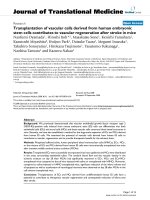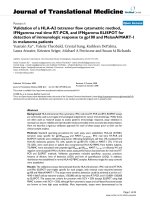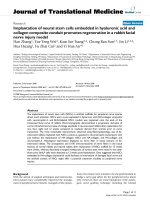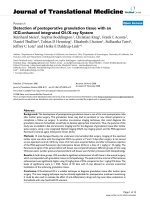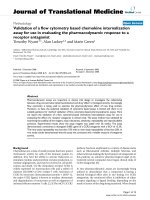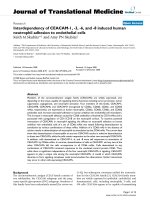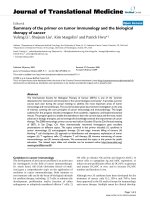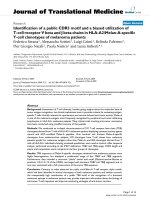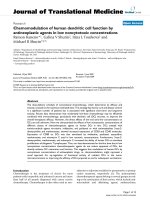Báo cáo hóa học: " Cloning of full genome sequence of hepatitis E virus of Shanghai swine isolate using RACE method" pptx
Bạn đang xem bản rút gọn của tài liệu. Xem và tải ngay bản đầy đủ của tài liệu tại đây (368.41 KB, 7 trang )
BioMed Central
Page 1 of 7
(page number not for citation purposes)
Virology Journal
Open Access
Research
Cloning of full genome sequence of hepatitis E virus of Shanghai
swine isolate using RACE method
Quan Shen
1,2
, Wen Zhang
1
, Xiangrong Cao
2
, Jing Mou
1
, Li Cui
1
and
Xiuguo Hua*
1
Address:
1
School of Agriculture and Biology, Shanghai JiaoTong University, 800 Dongchuan Road, Shanghai 200240, PR China and
2
School of
Life Science, Nanjing Normal University, 1 Wenyuan Road, Nanjing 210097, PR China
Email: Quan Shen - ; Wen Zhang - ; Xiangrong Cao - ;
Jing Mou - ; Li Cui - ; Xiuguo Hua* -
* Corresponding author
Abstract
Genotype 4 hepatitis E virus (HEV) was reportedly transmitted freely between humans and swine
in eastern China. The full-length genomic sequence of Shanghai swine isolate (SH-SW-zs1)
recovered from feces sample of a pig which was infected with HEV RNA positive swine serum was
determined using RT-PCR and RACE (Rapid Amplification of cDNA Ends) methods. The full
genome of the SH-SW-zs1 isolate was 7265 nucleotides in length and phylogenetic analysis
indicated that this isolate belonged to genotype 4. Comparison of the 3' UTR sequence with the
corresponding regions of other 38 HEV strains from different region revealed that the Shanghai
swine isolate is 21–49 bp longer than the other stains.
Introduction
Hepatitis E is an important public health disease in many
developing countries of Asia and Africa and also occurs
sporadically in some industrialized countries [1-4]. The
disease mainly affects young adults and has a relatively
high mortality of up to 25% in affected pregnant women
[1]. The main mode of transmission of hepatitis E virus
(HEV) is fecal-oral route, primarily through contaminated
water supplies [1]. HEV is single-stranded, positive-sense
RNA virus without an envelope [5]. The genome of HEV is
approximately 7.2 Kb and consists three open reading
frames (ORF1–3) [6]. ORF1 locates at the 5 ' end of
genome and encodes non-structural proteins, including
the methyltransferase, protease, helicase and RNA-
dependent RNA polymerase (RdRp) [7]. ORF2 maps to
the 3 ' terminus and encodes for a major structural pro-
tein, and ORF3 overlaps both and encodes a thus far
unknown function [6]. Based on sequence analysis, HEV
sequences have been classified into four major genotypes
(1–4). Genotype 1 is the main cause of hepatitis E in
developing countries in Asia and Africa, and genotype 2
has been documented in Mexico and Nigeria. Genotype 3
or 4 have been described in the United States, European
countries, China, Taiwan, and Japan [8,9]. The virus is
also prevalent in swine, and isolates from swine are genet-
ically closely related to that from humans [10-12]. Lots of
researches showed that genotype 4 and genotype 1 were
the major genotype in China, recently genotype 3 HEV
was reported in swine of Shanghai suburb [13]. For the
further research, such as genomic characteristics and phy-
logenetic analysis, the full genome of the isolate which
was proved prevalent in Shanghai swine was determined
in the current study.
Published: 9 October 2007
Virology Journal 2007, 4:98 doi:10.1186/1743-422X-4-98
Received: 2 August 2007
Accepted: 9 October 2007
This article is available from: />© 2007 Shen et al; licensee BioMed Central Ltd.
This is an Open Access article distributed under the terms of the Creative Commons Attribution License ( />),
which permits unrestricted use, distribution, and reproduction in any medium, provided the original work is properly cited.
Virology Journal 2007, 4:98 />Page 2 of 7
(page number not for citation purposes)
Materials and methods
Samples
132 serum samples of swine were collected from Shanghai
suburb in China. These samples were tested for HEV RNA,
using reverse transcriptase-polymerase chain reaction (RT-
PCR). One HEV RNA positive swine serum sample was
used for experimental infection of pigs [14]. HEV RNA
positive swine fecal samples were stored as 10% suspen-
sion in aliquots at 70°C. About 10 g of HEV RNA positive
fecal sample was converted to 10% (w/v) suspensions in
PBS (0.01 M, pH 7.2–7.4, added 0.1% DEPC) for deter-
mining the full genomic sequence of HEV.
Viral RNA extraction
One hundred microlitre of fecal suspensions was mixed
with 1 ml of trizol (invitrogen, USA). The mixture was
homogenized and incubated for 5 min at room tempera-
ture. Two hundred microlitre of chloroform was added
and the mixture was vigorously shaken for 15 s and incu-
bated at room temperature for 3 min. The aqueous phase
was transferred to a fresh microfuge tube after centrifuga-
tion at 12 000 g for 15 min at 4°C. Five hundred microli-
tre of isopropyl was added and the mixture was incubated
for 15 min at room temperatures. Then centrifuging at 12
000 g at 4°C for 15 min. After discarding the supernatant,
RNA pellet was washed with 1 ml 75% ethanol. The RNA
pellet was Dried at room temperature for 5 min after cen-
trifuging at 5 000 g for 5 min at 4°C and Discarding the
supernatant. RNA sample was dissolved with 20 ul DEPC-
treated water and used to reverse transcription immedi-
ately.
PCR amplification
Full-length primers: 18 sets of degenerate primers were
designed based on a multiple sequence alignment of
entire genome from isolates AY594199, DQ279091,
DQ450072 and AB108537 (table 1). Reverse transcrip-
tion was carried out at 42°C for 1 h with 1 ul (200 units)
of AMV Reverse Transcriptase (TakaRa, Japan) and 1 ul
(25 mM) of external antisense primer. The first round PCR
was carried using 10 ul of the synthesized cDNA and an
external set of forward and reverse primers with Ex Taq
DNA polymerase (TakaRa, Japan). A nested PCR was car-
ried out with internal primer set and 5 ul of the first PCR
product. The PCR parameters of all amplification reac-
tions included an initial incubation at 95°C for 9 min,
followed by 39 cycles of denaturation at 94°C for 1 min,
annealing for 1 min at a temperature varied according to
the Tm of different primers, and extension at 72°C for 1.5
min, with a final incubation at 72°C for 7 min. The result-
ing PCR products were excised from agarose gel and puri-
fied using the Axyprep DNA Gel Extraction Kit (AXYGEN,
USA). The purified PCR products were ligated into
PMD18-T vector (TakaRa, Japan) using T4 DNA ligase
(TakaRa, Japan) at 16°C overnight. The recombinant plas-
mid was transformed into DH5α competent Escherichia
coli cells (TakaRa, Japan). Plasmids containing the insert
fragment were identified by PCR. Three of the positive
clones were sequenced.
5'RACE
The 5'RACE was carried out with the 5-Full RACE Core Set
(TaKaRa, Japan) kit following the manufacture's instruc-
tions. Briefly, 1st strand cDNA was Synthesized by reverse
transcription using 5'end-phosphorylated RT Primer
which was specific to the swine HEV (5'-p-GTCATRCCRT-
GGCG-3'). The PCR reaction mixture was incubated for 2
min at 94°C followed by 35 amplification cycles, com-
prising denaturation at 94°C for 30 s, annealing at 65°C
for 30 s and extension at 72°C for 30 s. The reaction was
extended for another 7 min at 72°C to insure the full
extension. Fifteen ul of 1st Strand cDNA was treated with
RNase H in a total 75 µl reaction mixture containing 15 ul
of Hybrid RNA Degeneration Buffer for 1 h at 30°C. The
mixture was then precipitated at -20°C for 30 min, being
added 100 ul of H
2
O and 500 ul 100% ethanol. The
supernatant was discarded and the pellet was washed with
75% ethanol after centrifuging at 12 000 g for 5 min. The
pellet was dissolved with 8 ul of RNA (ssDNA) Ligation
Buffer and 12 ul of H
2
O after dried at room temperature
for 5 min. 20 ul of 40% PEG-6000 and 1 ul of ligase were
added and incubated at 16°C overnight. Fifteen microlit-
ers of circled cDNA was then used as template for nested
PCR using ExTaq DNA polymerase (TaKaRa, Japan)with
two sets of primers: 5'-CGGAGTTGGCCGCTGCTAGAG-
3'(external forward primer, nucleotide position numbers
104 to 84), 5'-TGTACT(G)TTTGCTGCTGAGAC-3'(exter-
nal reverse primer, nucleotide position numbers 482 to
501), 5'-ATTGGGTGATTCCACAG(A)AACCTC-3'(inter-
nal forward primer, nucleotide position numbers 225 to
203), and 5'-ATCCACAAC(T)GAGCTT(C)GAGCAG-
3'(internal reverse primer, nucleotide position numbers
236 to 256). The PCR reaction mixture was incubated for
2 min at 94°C followed by 35 amplification cycles, com-
prising denaturation at 94°C for 30 s, annealing at 65°C
for 30 s and extension at 72°C for 30 s. The reaction was
extended for another 7 min at 72°C to insure the full
extension. The final PCR product was analyzed on 20 g/L
agarose gel.
3'RACE
The 3'RACE was carried out with the TaKaRa RNA PCR Kit
(TaKaRa, japan) following the manufacture's instructions.
Brifely, ten microliters of the HEV RNA was used as tem-
plate to synthesize cDNA with AMV Reverse transcriptase
for 1 h at 42°C. The external reverse primer (HE17A)
which has a poly (T) tract was used to prime the cDNA
synthesis. The cDNA was then amplified by nested PCR
with the external forward primer (5'-CGCTCACTACTATC-
CAGCAG-3', nucleotide position numbers 6763–6782)
Virology Journal 2007, 4:98 />Page 3 of 7
(page number not for citation purposes)
Table 1:
Primer name Nucleotide position Nucleotide sequence (5'-3')
HE0ES 104-84 CGGAGTTGGCCGCTGCTAGAG
HE0EA 482–501 TGTACT(G)TTTGCTGCTGAGAC
HE0IS 225-203 ATTGGGTGATTCCACAG(A)AACCTC
HE0IA 236–256 ATCCACAAC(T)GAGCTT(C)GAGCAG
HE1ES 11–32 TATGTGGTCGACGCCATGGAGG
HE1EA 528-509 GCCCTTTATTCACTGCACGA
HE1IA 573-554 ATACCGTGGCGAGCCATTGC
HE2ES 482–501 TGTACTTTTGCTGCTGAGAC
HE2EA 956–975 ACAGGGACGGCATGAAATGT
HE2IS 437–454 CTTCCACCTGT(C)T(C)GAT(C)CGG
HE2IA 1000-983s AAGCATA(G)AGCCTGTCCCA
HE3ES 671–692 CGTGCA(T)GTG(A)ATTACATAT(C)GAGG
HE3EA 1336-1317 CCACCGG(T)CGAA(G)CACTGG(A)GCAT
HE3IS 742–762 GATCCGT(G)ACC(G)ACT(C)AAGGTCAC
HE3IA 1314-1293 AACTG(C)CAA(G)CTGA(G)CGA(G)CCAGGGA
HE4ES 984–1005 GGGACAGGCTTATGCTTTTTGG
HE4EA 1528-1508 TGCCTCATTATCATAACCCTG
HE4IS 956-975 ACGTTTCATGCCGTCCTGT
HE4IA 1703-1684 GGCCGTCG(A)GCA(G)TCAGAG(A)ACC(T)
HE5ES 1331-1348 CGGTGGT(C)TG(A)TCTGCC(T)GGC
HE5EA 1792-1746 GTTGAG(A)AAGGTT(C)TTATTG(A)
HE5IS 1310–1329 C(G)AGTTT(C)TATGCCCAGTGTCG
HE5IA 1803-1785 GACAG(A)C(G)ACATAC(T)TGCTCT(C)G
HE6ES 1508–1528 CAGGGT(C)TATGAT(C)AAT(C)GAGGC
HE6EA 2529-2510 GGGAAC(A)CGT(C)TGA(G)TAGAAT(A)GC
HE6IS 1679–1700 GTTGAG(A)GTC(T)TCTGAT(C)GCC(T)GACG
HE6IA 2477-2457 GGTTA(G)GAT(C)GCATTA(G)ACCAGCC
HE7ES 2028–2048 TGTGGTAC(T)T(C)AC(T)CCTGAGGGGC
HE7EA 2144-2123 CTCTACACT(C)CGG(T)ACCTGGTCGG
HE7IS* 2830–2850 GTAAGGGCTGGAAGGGTGGGC
HE7IA* 2913-2893 ACTTCAGTGGCGGAGTCTAAC
HE8ES 2753–2772 GCCTGGGAACGTAACCACCG
HE8EA 3366-3347 GTCTGGATC(T)TTT(C)GGGTACGC
HE8IS 2714–2733 GCCGGC(T)ATATATAAGGTC(A)CC
HE8IA 3438-3416 GCCTGGGTG(A)AAT(C)ACCAA(G)CTTCT(C)G
HE9ES 3209–3228 GGTGAC(T)CCC(T)AAT(C)AAT(C)AAATCCC
HE9EA 3948-3929 GGCGCTGCCATACGGCAGTG
HE9IS 3312–3334 GATGC(T)CCGGCG(A)GAT(C)GTCTGTGAG
HE9IA 3810-3791 GGTCGA(G)TGGCCAAGC(T)TCCTC
HE10ES 3764–3781 CAGTTTAGTGCT(C)TAC(T)CAG
HE10EA 4432-4413 ATCATTCTCAAAAACCTTAC
HE10IS 3587–3605 ACG(T)GAGAAG(A)TGTGTGGTG(C)G
HE10IA 4518-4496 CACTCC(T)TCCATGATTATACACTC
HE11ES 4290–4311 TGTTC(T)GGCCCA(C)TGGTTT(C)CGCGC
HE11EA 4752-4733 CGATAGTCACTACAGAGCAC
HE11IS 4355–4375 TATGGTGATGCA(G)TATGAG(A)GAC
HE11IA 4736-4717 GCACAACAGAATCATCTCCC
HE12ES 4607–4625 TGGAAGAAA(G)CAT(C)TCTGGTG
HE12EA 5253-5233 CCGGTGGCGCGGGCAGCATAG
HE12IS 4496–4518 GAGTGTATAATCATGGAG(A)GAGTG
HE12IA 5347–5366 GGTTGGATGAATATAGGGGA
HE13ES 4977-4997 CGAATGTGGCTCAGGTTTGTG
HE13EA 5451-5431 GCCAAGCGGAACCGAGTGGAC
HE13IS 5020–5039 CGGTGTTAGCCCTGGCTTGG
HE13IA 5392-5371 GTTGGAATGTCGGATGCGAAGG
HE14ES 5347–5366 TCCCCTATATTCATCCAACC
HE14EA 5956-5934 TGATTG(T)CGATAG(A)TGCAGGCGCTC
HE14IS 5233–5252 CTATGCTGCCCGCGCCACCG
HE14IA 5980-5957 GAGGTCTCAACT(C)GAG(A)CGCCAA(G)CCC
Virology Journal 2007, 4:98 />Page 4 of 7
(page number not for citation purposes)
and internal forward primer (5'-CTAAGACCTTCTTTGT-
TCTGCC-3', nucleotide position numbers 6787–6808)
with ExTaq DNA polymerase (TaKaRa, Japan). The PCR
reaction mixture was incubated for 2 min at 94°C, fol-
lowed by 35 amplification cycles comprising denatura-
tion at 94°C for 30 s, annealing at 65°C for 30 s, and
extension at 72°C for 30 s. The reaction was extended for
another 7 min at 72°C to ensure the full extension.
Phylogenetic analysis
Using Clustal × 1.8, multiple alignments of nucleotide
sequences was carried out. The phylogenetic status SH-
SW-zs1 isolate was assessed employing the software
MEGA Version 2.1[15]. For analysis in MEGA, Jukescantor
(JC) distance was utilized employing the Neighbor join-
ing (NJ) algorithm. The reliability of different phyloge-
netic groupings was evaluated by using the bootstrap test
(1000 bootstrap replication) available in MEGA. Acces-
sion numbers, designations and countries of origin of the
full genome sequences employed for analysis in the
present study were as follows:
Genotype 1: AF051830, Nepal; X99441, India; AF076239,
India; AF459438, India; D10330, Burma; M73218,
Burma; AF185822, Pakistan; X98292, India; L25595,
China; M80581, Pakistan; AY230202, Morocco.
Genotype 2: M74506, Mexico.
Genotype 3: AP003430, Japan, human; AB091394, Japan,
human; AB073912, Japan, swine; AY115488, Canada,
swine; AF060668, US, human; AF082843, US, swine;
AB089824, Japan, human; AB074918, Japan, human;
AB074920, Japan, human.
Genotype 4: AB091395, Japan, human; AB097812, Japan,
human; AB097811, Japan, swine; AB074915, Japan,
human; AB074917, Japan, human; AJ272108, China,
human; AB108537, China, human; AB161717, Japan,
human; AB161718, Japan, human; AB161719, human;
DQ450072, China, swine; AY594199, China, swine;
DQ279091, China, swine; AB197673, China, human;
EF077630, China, swine; AB197674, human.
Avian Hepatitis E virus (AY535004) was chosen as an out-
group. The sequence reported here has been deposited
with GenBank accession no.: EF570133
.
Results
3'RACE
As shown in Figure 1, 3'RACE band of the expected size
was obtained. The 3' terminus of this study had 93 nucle-
otides upstream of the polyA. The sequence of 3'UTR was:
TTT ATT CTT CTT GTA CCT CCC CTT CGG TTC TGT TTC
TTT TTA TTT CTC CTT TCT GCG TTC CGC GCT CAC TAC
TAT CCA GCA GGA TCC ATG TTG. Comparison of the
3'UTR sequence with the corresponding regions of other
38 HEV strains from different region of the world revealed
that the Shanghai swine isolate is 21–49 bp longer than
all the other stains (additional file).
Analysis of Full-Length Genome of Shanghai Isolate
The genomic length of the SH-SW-zs1 isolate was deter-
mined to be 7265 nucleotides (nt) excluding poly (A) tail
at 3' terminus and contained three open reading frames
(ORFs) similar to earlier reported human and swine HEV
isolates. The genomic organization consisted of 5'
untranslated region (5'UTR) of 25 nt (1–25), ORF-1 of
5127 nt (26–5152), ORF-2 of 1983 nt (5190–7172),
ORF-3 of 372 nt (5249–5520) and 3'UTR of 93 nt (7173–
7265), followed by a poly (A) tail of 26 residues. The
HE15ES 5922–5942 GTGATT(C)CCTAGT(C)GAGCGCCTG
HE15EA 6415-6397 GTCGGCTCGCCATTGGCTG
HE15IS 5877–5896 ACTGATGTCCGC(G)ATC(T)CTTGT
HE15IA 6453-6433 CCTGCTGAGCATTCTCGACTG
HE16ES 6336–6357 CTC(A)CCGACAGAATTGATTTCGT
HE16EA 7005-6985 CAGAG(A)TGA(G)GGT(G)GCA(G)AGGACAC
HE16IS 6271–6292 TTGGTGAG(A)GTT(C)GGC(T)CGTGGTAT
HE16IA 7074-7054 CAGGGCAA(G)AG(A)ATCATCG(A)AAAG
HE17ES* 6763–6782 CGCTCACTACTATCCAGCAG
HE17IS* 6787–6808 CTAAGACCTTCTTTGTTCTGCC
HE17A GTTTTCCCAGTCACGACTTTTTTTTTTTTTTT
*: the primers
were designed
according to
isolate in this
study.
Position and nucleotide sequence of oligonucleotide primers for PCR. The nucleotide position is in accordance with the SH-SW-zs1 isolate in this
study. In the primer name, ES, EA, IS and IA mean "external sense", "external antisense", "internal sense" and "internal antisense", respectively.
Letters in parentheses indicate degenerate bases.
Table 1: (Continued)
Virology Journal 2007, 4:98 />Page 5 of 7
(page number not for citation purposes)
length of 5'UTR was same as that of other type 4 isolates
and had nucleotide G at the extreme 5' end of the genome
as other reported genotype 4 sequences. Whole genome-
based phylogenetic analysis confirmed classification of
Shanghai swine in genotype 4 (Fig. 2). The phylogenetic
tree showed that genotype 4 could be divided into 3 main
subgroups. SH-SW-zs1 isolate closely clustered with iso-
late DQ450072 which was isolated from eastern China,
and they shared 89.3% identity (with divergence of
11.3%) with each other and represented a distinct sub-
group among the genotype 4 isolates with a bootstrap
value of 100%.
Discussion
HEV is the major cause of enterically transmitted non-A,
non-B, non-C hepatitis and is responsible for significant
morbidity and mortality in developing countries [16].
Outbreaks of hepatitis E have been described in Asia,
Africa and Mexico [16-18], while sporadic cases have been
reported in the United States, Japan and other developed
countries [8]. It has been shown that HEV is a zoonotic
virus [19,20]. Hitherto, the lack of an efficient cell-culture
system for HEV has greatly hampered detailed analysis of
the virus replication cycle in infected cells, which makes it
difficult to resolve many important questions. Mean-
while, cloning full-length genome of HEV is an efficient
way to analysis molecular character, viral replication and
other problems. Some reports indicated that genotype 4
and genotype 1 were the major genotype in China, though
genotype 3 HEV was recently found in swine of Shanghai
suburb [13]. Recent observations suggested that the HEV
genotype influences the severity of hepatitis E, and that
genotype 4 is associated more strongly with the severe
form of hepatitis E than genotype 3 [21]. Therefore, the
genomic full-length of the Shanghai isolate was deter-
mined in this study for further demonstrating the HEV
strain prevalent in eastern China. The full genome of the
SH-SW-zs1 isolate was 7265 nucleotides in length and
phylogenetic analysis indicated that this isolate belonged
to genotype 4. This isolate closely clustered with isolate
DQ450072 and they shared 89.3% identity(with diver-
gence of 11.3%) with each other and represented a dis-
tinct subgroup among the genotype 4 isolates with a
bootstrap value of 100%, thus suggested that they may
come from one common strain. Result of comparison
showed that the 3'UTR of this Shanghai isolate was 21–49
bp longer than all the other stains so far avalible on-line.
By blast the 21-nt-fragment in GenBank, we found it has
many homologous sequences which shared more than
85% identity with it. So we presumed that this fragment
may come from the recombination of genome HEV and
its host or other microorganism. The true origin of this
short fragment and its specific function need to be further
studied.
RT-PCR products of SH-SW-zs1 isolateFigure 1
RT-PCR products of SH-SW-zs1 isolate. The right side
shows the primers and the expected length of the fragment;
Arrows display the aimed bands.
Virology Journal 2007, 4:98 />Page 6 of 7
(page number not for citation purposes)
Phylogenetic trees constructed using MEGA software depicting genotypic status of SH-SW-zs1 on the basis of full-length genome sequence of 39 HEV isolatesFigure 2
Phylogenetic trees constructed using MEGA software depicting genotypic status of SH-SW-zs1 on the basis of full-length
genome sequence of 39 HEV isolates. Genbank accession numbers for the full genome were marked at each branch. Percent
bootstrap support is indicated at each node. The abbreviations Ch and Ja stand for China and Japan, respectively.
Publish with BioMed Central and every
scientist can read your work free of charge
"BioMed Central will be the most significant development for
disseminating the results of biomedical research in our lifetime."
Sir Paul Nurse, Cancer Research UK
Your research papers will be:
available free of charge to the entire biomedical community
peer reviewed and published immediately upon acceptance
cited in PubMed and archived on PubMed Central
yours — you keep the copyright
Submit your manuscript here:
/>BioMedcentral
Virology Journal 2007, 4:98 />Page 7 of 7
(page number not for citation purposes)
Additional material
Acknowledgements
This study was supported by Key Project of Shanghai Science and Technol-
ogy Committee of China. (No.06391912).
References
1. Emerson SU, Purcell RH: Hepatitis E virus[J]. Rev Med Virol 2003,
13(3):145-154.
2. Kabrane-Lazizi Y, Zhang M, Purcell RH, Miller KD, Davey RT, Emer-
son SU: Acute hepatitis caused by a novel strain of hepatitis E
virus most closely related to United States strains. J Gen Virol
2001, 82:1687-93.
3. Schlauder GG, Desai SM, Zanetti AR, Tassopoulos NC, Mushahwar
IK: Novel hepatitis E virus (HEV) isolates from Europe: evi-
dence for additional genotypes of HEV. J Med Virol 1999,
57(3):243-51.
4. Takahashi M, Nishizawa T, Yoshikawa A, Sato S, Isoda N, Ido K, Sug-
ano K, Okamoto H: Identification of two distinct genotypes of
hepatitis E virus in a Japanese patient with acute hepatitis
who had not travelled abroad. J Gen Virol 2002, 83:1931-40.
5. Purcell RH, Emerson SU: Animal models of hepatitis A and E.
ILAR J 2001, 42(2):161-177.
6. Tam AW, Smith MM, Guerra ME, Huang CC, Bradley DW, Fry KE,
Reyes GR: Hepatitis E virus (HEV): molecular cloning and
sequencing of the full-length viral genome. Virology 1991,
185(1):120-31.
7. Koonin EV, Gorbalenya AE, Purdy MA, Rozanov MN, Reyes GR, Bra-
dley DW: Computer-assisted assignment of functional
domains in the nonstructural polyprotein of hepatitis E virus:
delineation of an additional group of positive-strand RNA
plant and animal viruses. Proc Natl Acad Sci USA 1992, 89:8259-63.
8. Schlauder GG, Mushahwar IK: Genetic heterogeneity of hepati-
tis E virus. J Med Virol 2001, 65(2):282-292.
9. Mizuo H, Suzuki K, Takikawa Y, Sugai Y, Tokita H, Akahane Y, Itoh K,
Gotanda Y, Takahashi M, Nishizawa T, Okamoto H: Polyphyletic
strains of hepatitis E virus are responsible for sporadic cases
of acute hepatitis in Japan. J Clin Microbiol 2002, 40:3209-3218.
10. Drobeniuc J, Favorov MO, Shapiro CN, Bell BP, Mast EE, Dadu A,
Culver D, Iarovoi P, Robertson BH, Margolis HS: Hepatitis E virus
antibody prevalence among persons who work with swine. J
Infect Dis 2001, 184:1594-1597.
11. Lu L, Li C, Hagedorn CH: Phylogenetic analysis of global hepa-
titis E virus sequences: genetic diversity, subtypes and zoon-
osis. Rev Med Virol 2006, 16:5-36.
12. Zheng Y, Ge S, Zhang J, Guo Q, Ng MH, Wang F, Xia N, Jiang Q:
Swine as a principal reservoir of hepatitis E virus that infects
humans in eastern China. J Infect Dis 2006, 193:1643-1649.
13. Ning H, Niu Z, Yu R, Zhang P, Dong S, Li Z: Identification of gen-
otype 3 hepatitis E virus in fecal samples from a pig farm
located in a Shanghai suburb. Vet Microbiol 2007, 121:125-130.
14. Arankalle VA, Chobe LP, Jha J, Chadha MS, Banerjee K, Favorov MO:
Aetiology of acute sporadic non-A, non-B hepatitis in west-
ern India. J Med Virol 1993, 40:121-125.
15. Kumar S, Tamura K, Nei M: MEGA3: Integrated software for
Molecular Evolutionary Genetics Analysis and sequence
alignment. Briefings in Bioinformatics 2004, 5:150-163.
16. Harrison TJ: Hepatitis E virus-an update. Liver 1999, 19:171-176.
17. Arankalle VA, Chadha MS, Chitambar SD, Walimbe AM, Chobe LP,
Gandhe SS: Changing epidemiology of hepatitis A and hepati-
tis E in urban and rural India (1982–98). J Viral Hepat 2001,
8:293-303.
18. van Cuyck-Gandre H, Caudill JD, Zhang HY, Longer CF, Molinie C,
Roue R, Deloince R, Coursaget P, Mamouth NN, Buisson Y: Short
report: polymerase chain reaction detection of hepatitis E
virus in north African fecal samples. Am J Trop Med Hyg 1996,
54:134-135.
19. Clayson ET, Shrestha MP, Vaughn DW, Snitbhan R, Shrestha KB,
Longer CF, Innis BL: Rates of hepatitis E virus infection and dis-
ease among adolescents and adults in Kathmandu, Nepal. J
Infect Dis 1997, 176:763-766.
20. Meng XJ, Purcell RH, Halbur PG, Lehman JR, Webb DM, Tsareva TS,
Haynes JS, Thacker BJ, Emerson SU: A novel virus in swine is
closely related to the human hepatitis E virus. Proc Natl Acad
Sci USA 1997, 94:9860-9865.
21. Mizuo H, Yazaki Y, Sugawara K, Tsuda F, Takahashi M, Nishizawa T,
Okamoto H: Possible risk factors for the transmission of hep-
atitis E virus and for the severe form of hepatitis E acquired
locally in Hokkaido, Japan. J Med Virol 2005, 76(3):341-349.
Additional file 1
Comparison of length in the 5'UTR of different HEV stains. The numbers
in the brackets show the genotype designation.
Click here for file
[ />422X-4-98-S1.tiff]
